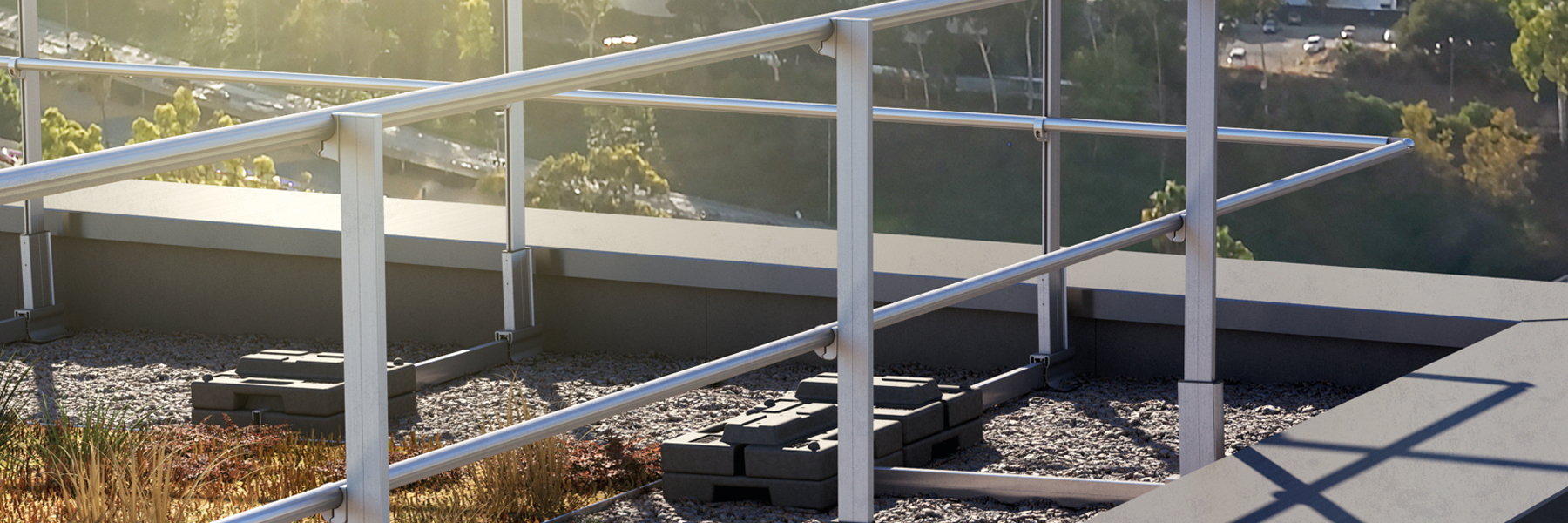Roofs are not actually designed for continuous foot traffic, but due to repair and inspection jobs, the workers need to tread lightly across metal panels and membranes. Therefore, most of the roof accidents include falls and trips from heights that lead to numerous deaths every year along with different types of non-fatal injuries.
Use of roof safety railings:
The roof safety railings are non-penetrating railings that prevent roof leakage successfully. The majority of these railings are designed in such a way that these can be assembled on the roof surface quite easily without the need of penetrating the roof membrane. This system mainly works on the proven counterweight system where recycled PVC weight offers non-slip and high visibility secure base, which don’t penetrate the roof membrane. Implementation of the blocking devices is helpful in mitigating the accidental falls from dangerous elevations like from a leading edge, from an access point, on a building, roof, walkway or any other hazardous location.

Besides, the tube delivers collection protection and galvanized fittings ensure a protected work environment for people working on the roof. As these railings are engineered for structural soundness, therefore these can reduce the chance of potential injuries and fatal falls drastically. These railings also meet the necessities of the Australian height safety standards and regulations to maximize the level of safety while minimizing the risk.
The use of roof safety railings is also applied to skylights, hatches and different types of openings. Here the locations include but not just limited to:
The most important characteristic of a roof safety railing is the strength, and the next thing is sturdiness. The efficiency of a good roof safety railing entirely depends on the features like:
Benefits that a good roof safety railing can offer:
Use of roof safety railings:
The roof safety railings are non-penetrating railings that prevent roof leakage successfully. The majority of these railings are designed in such a way that these can be assembled on the roof surface quite easily without the need of penetrating the roof membrane. This system mainly works on the proven counterweight system where recycled PVC weight offers non-slip and high visibility secure base, which don’t penetrate the roof membrane. Implementation of the blocking devices is helpful in mitigating the accidental falls from dangerous elevations like from a leading edge, from an access point, on a building, roof, walkway or any other hazardous location.

Besides, the tube delivers collection protection and galvanized fittings ensure a protected work environment for people working on the roof. As these railings are engineered for structural soundness, therefore these can reduce the chance of potential injuries and fatal falls drastically. These railings also meet the necessities of the Australian height safety standards and regulations to maximize the level of safety while minimizing the risk.
The use of roof safety railings is also applied to skylights, hatches and different types of openings. Here the locations include but not just limited to:
- Evacuation Areas
- Controlled Access Zones
- Holes that include skylights
- Leading Edges
- Roofing
The most important characteristic of a roof safety railing is the strength, and the next thing is sturdiness. The efficiency of a good roof safety railing entirely depends on the features like:
- Construction as per the specifications of the designer
- Appropriate design
- Examination and testing after manufacturing
- Proper installation by an expert
- Instructions that support the maintenance and use of that system
- Proper use
Benefits that a good roof safety railing can offer:
- This system can offer collection protection for all the people working on the roof
- Minimum components are used for easy installation
- This system works on a verified counterbalance system
- Here the sections can be taken down or can be added for reconstructing the railing somewhere else
- The modular design of this railing permits reconstruction on the site if needed
- This system is compatible with different types of configurations of the roof up to the slope of 10 degrees
- This system is suitable to use on different types of roof surfaces including asphalt, concrete, felt and PVC membrane
Comments
Post a Comment